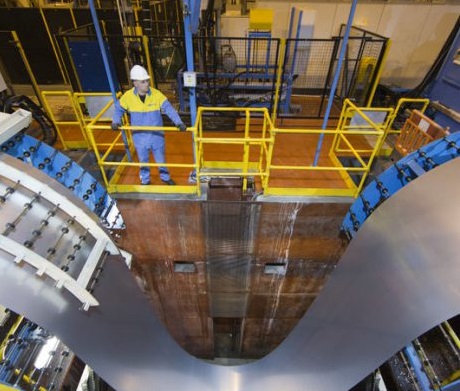5 things construction can learn from automotive
On a recent visit, Constructing Excellence was hosted by Tata Steel at its distribution and processing centre at Wednesfield, West Midlands, the largest in the UK. Tata Steel has invested heavily in the facility including more than £12m in a dedicated Automotive Service Centre to produce sophisticated differentiated steel products.
The visit inspired questions around how the business case was made for the automotive investment.
Contents |
[edit] 1. Long term relationships
Suppliers invest in production facilities on the basis of long-term and certain demand based on standardisation and systemisation, making it easier to make long-term investments in manufacturing facilities.
It can take two years of discussions with clients before a part gets put on the production line. The steel industry is not without risks but those risks are clearly identified and understood so investments can be justified.
[edit] 2. Is lack of people a good thing?
The group were struck by the limited number of people on the shop floor, prompting a debate about whether reduced labour requirements associated with the manufacturing revolution was a good thing. Levels of automation mean a higher level of training and therefore opportunities to improve the workforce skillset and flexibility. High quality production and just-in-time service also require resources and training in quality assurance, planning and health, and safety to support the supply chain.
[edit] 3. Manufacturer-led construction?
The aim for manufacturers like Tata Steel is to change the perception of steel as just a commodity and to add value to get closer to its clients and really understand their requirements and how they define value. This requires a movement away from traditional supply chains towards more integrated supply chains.
[edit] 4. Can existing procurement practices support this?
Procurement processes are in place to manage risk, and particularly in the public sector to ensure fairness and transparency. There was a heated discussion about whether the existing complex supply chain can be open and whether they do deliver transparency and that current processes were skewed towards traditional delivery.
It was suggested that existing procurement processes can get in the way of early manufacturer engagement and limit some of the advantages of offsite. Moreover, passing risk down the supply chain has the effect of multiplying risk.
[edit] 5. Generative design tools
Generative design tools and a platform-based approach with a pallet of products will help construction take better advantage of manufacturing and its added value. This relates to the work that Constructing Excellence member Blacc has been undertaking to identify a kit of parts for the education sector that can be configured to suit specific site and client requirements, while still meeting Education Funding Agency requirements at higher spec and lower costs.
Alex Lubbock, head of digital construction at the Infrastructure Projects Authority, led a discussion on how the IPA’s Transforming Infrastructure Performance programme is designed to support government engagement with industry to shift to a presumption in favour of offsite outlined in the autumn budget of 2017.
Some of the key areas include:
- Finding ways to enable early manufacturer engagement while remaining compliant with European procurement regulations. This will enable tenders and procurement to be delivered in a way that supports innovation and SME involvement.
- Generating a pipeline of repeatable projects and elements that can unlock long-term investment and enable the industry to build on knowledge and transfer learning more effectively between projects.
Throughout the visit, the message was reinforced that early decisions on offsite were required in order to deliver real value for clients.
This article was originally published here on 7th Feb 2018 by BRE Buzz.
--BRE Buzz
[edit] Related articles on Designing Buildings Wiki
Featured articles and news
Government consultations for the summer of 2025
A year of Labour, past and present consultations on the environment, the built environment, training and tax.
CMA competitiveness probe of major housing developers
100 million affordable housing contributions committed with further consultation published.
Homes England supports Greencore Homes
42 new build affordable sustainable homes in Oxfordshire.
Zero carbon social housing: unlocking brownfield potential
Seven ZEDpod strategies for brownfield housing success.
CIOB report; a blueprint for SDGs and the built environment
Pairing the Sustainable Development Goals with projects.
Types, tests, standards and fires relating to external cladding
Brief descriptions with an extensive list of fires for review.
Latest Build UK Building Safety Regime explainer published
Key elements in one short, now updated document.
UKGBC launch the UK Climate Resilience Roadmap
First guidance of its kind on direct climate impacts for the built environment and how it can adapt.
CLC Health, Safety and Wellbeing Strategy 2025
Launched by the Minister for Industry to look at fatalities on site, improving mental health and other issues.
One of the most impressive Victorian architects. Book review.
Common Assessment Standard now with building safety
New CAS update now includes mandatory building safety questions.
RTPI leader to become new CIOB Chief Executive Officer
Dr Victoria Hills MRTPI, FICE to take over after Caroline Gumble’s departure.
Social and affordable housing, a long term plan for delivery
The “Delivering a Decade of Renewal for Social and Affordable Housing” strategy sets out future path.
A change to adoptive architecture
Effects of global weather warming on architectural detailing, material choice and human interaction.
The proposed publicly owned and backed subsidiary of Homes England, to facilitate new homes.
How big is the problem and what can we do to mitigate the effects?
Overheating guidance and tools for building designers
A number of cool guides to help with the heat.
The UK's Modern Industrial Strategy: A 10 year plan
Previous consultation criticism, current key elements and general support with some persisting reservations.
Building Safety Regulator reforms
New roles, new staff and a new fast track service pave the way for a single construction regulator.


























